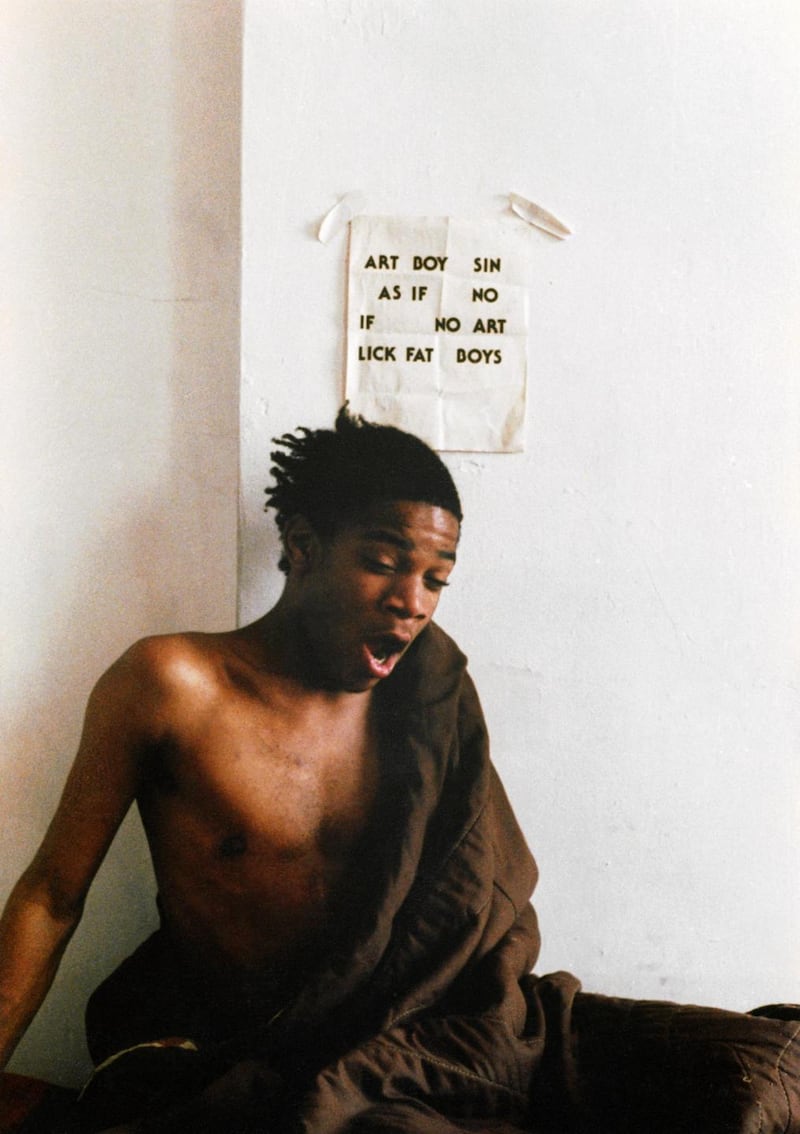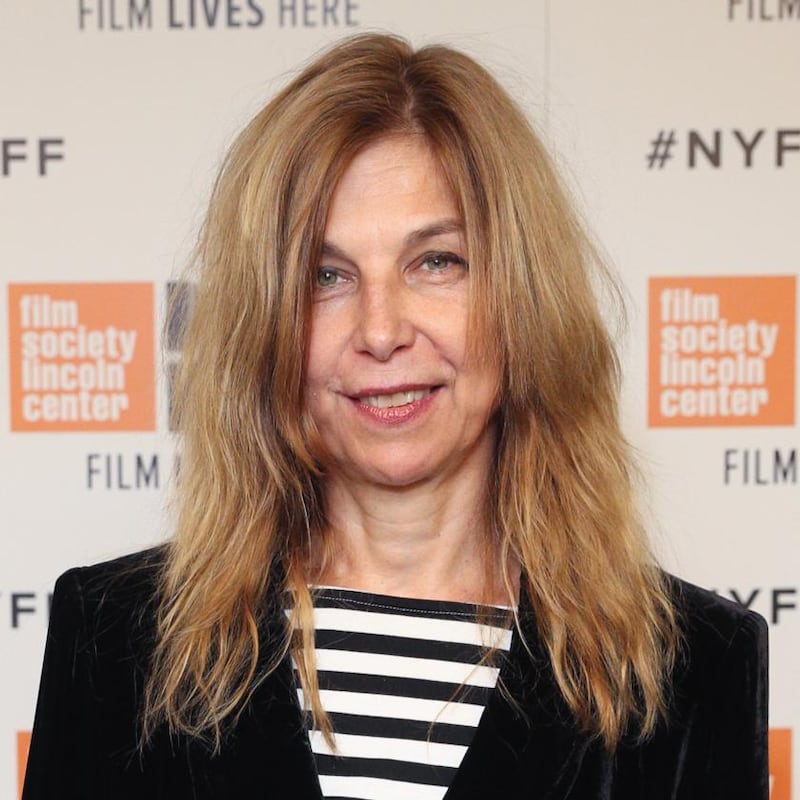Sara Driver's new picture, Boom for Real, about the late teenage years of the New York artist Jean-Michel Basquiat, is a huge cause for celebration. Let us count the ways.
Boom is a fascinating chronicle of the formative years of the American artist, who died in 1988, comprising material that was feared lost during Hurricane Sandy, now fondly catalogued by a film-maker who, herself, has often been feared lost.
Let's start with Basquiat. In the weeks after Sandy had ravaged New York, Driver met Alexis Adler, an embryologist who started one of the first fertility programmes in New York City and an old friend from the Lower East Side of Manhattan in the late 1970s and early 1980s.
Alexis Adler had a mural up in her bedroom and on a refrigerator door and on her bathroom door. And it was only when she thought things were lost that she revisited them
Basquiat lived with Alder between 1979 and 1980 and had left her with a sizeable collection of drawings and writings. When the floodwater hit the bank vault where she had stashed those materials, she panicked and retrieved them as quickly as she could.
Who could blame her? Last year, a Basquiat piece set a price record price for an American artist when an untitled skull painting from 1982 was bought by a Japanese billionaire named Yusaku Maezawa for $110.5 million, after a 10-minute bidding war at Sotheby's.
“Hurricane Sandy had flooded the entire Lower East Side,” says Driver. “It was a disaster. We didn’t have power for eight to 10 days. When Jean-Michel was living with Alexis he did drawing around the house. She had a mural up in her bedroom and on a refrigerator door and on her bathroom door. And it was only when she thought things were lost that she revisited them. So I bought a camera and started shooting.
“There was more than 60 drawings by him. There was a notebook. There were more than 150 photographs that she had taken of him that were really fun and beautiful and playful. I guess I was one of the first people to see everything. She was getting nervous about preserving the murals and was afraid she’d have to split the collection up in order to finance the preservation. So I was there to document. But when I saw it all, I thought this is not only a great insight into him but also great insight into downtown New York between 1978 and 1981.”

Boom for Real, which marries home movies, archive footage and contemporary talking heads, is part of a growing subgenre of films about Basquiat, including an eponymous 1998 biopic starring Jeffrey Wright, and the documentaries Jean-Michel Basquiat: The Radiant Child (2010) and Basquiat: Rags to Riches (2017).
Unlike these films, Driver studiously avoids the dirty glamour of Basquiat’s later years, when Madonna was his girlfriend, when his paintings were increasingly hot, and when he descended into the heroin addiction that would result in his death, aged 27.
Interestingly, Boom for Real – for all its unseen footage of Basquiat – never features his voice, lending him a grander, phantasmagorical quality. It is, despite this deliberate distancing, the fondest, warmest depiction of the late artist to date, a film characterised by smiling, laughing recollections and spritely contemporaneous shots.
"Jean-Michel was like his own university," says Driver. "He was always gathering material and information and storing it away. He'd study Alexis's medical books. He'd hang out with Lee Quiñones, who was, and is, one of the leading graffiti masters of all time. Or Fab Five Freddy, who turned him on to bebop. He'd talk to Jim [Jarmusch] about film and poetry. Anyone who was trying to find their way in their own field."
New York’s wild days
That New York of the late 1970s and early 1980s – for all the romance of the recent documentaries Kill Your Idols and Blank City – was no picnic. After a nationwide economic recession in the early 1970s, the middle classes had abandoned Manhattan in favour of the suburbs and satellite towns, leaving the city to fester as unemployment and crime reached historic highs. Empty spaces were consequentially adopted as artists' garrets. Their output was characterised by an understandable sense of urgency.
Driver had always been fascinated by the city. She remembers that her older sister had a poster from Andy Warhol’s Factory studio on her bedroom wall. Her father, a lawyer, and her mother, a businesswoman, both worked in New York. Her mother would frequently drop Driver at the cinema while she went to meetings. “She thought I’d get good at French if I watched enough French movies,” laughs Driver. “But all that happened was I got confused about sex.”
Everyone had forgotten just how bombed out it actually was. It was a very different city
Having graduated from Randolph-Macon Woman’s College with a degree in theatre and classics, and, after spending a year in Athens training in archaeology, she decided the discipline was too sexist. Instead, she turned to the graduate film programme at NYU.
As Driver recalls, the New York streets were dangerous. They still didn’t know what Aids was called, but everyone would throw a key in a sock out a window for someone they recognised below on the street.
“It was totally bombed out,” she says. “When the film was shown at the New York Film Festival people were shocked. Even the people who were there. Everyone had forgotten just how bombed out it actually was. It was a very different city. But, in a way, it was more human than it is now.”
Driver, in common with her friend Basquiat, was part of a community that would produce modern artists like Keith Haring and Jeff Koons, film-makers like Vivienne Dick, Amos Poe and Eric Mitchell, musicians like Arthur Russell, and such pioneers of hip-hop and graffiti as Fab Five Freddy and Lady Pink.
This fledgling scene was rife with crossovers: Fab Five Freddy started out as the cameraman on Glenn O'Brien's iconic public access cable show, TV Party, the conceptual artist Jenny Holzer collaborated many times withLady Pink, Driver herself worked in the equipment room of NYU's film programme with Spike Lee and Ernie Dickerson.
"Everyone wanted to get their signal out like artists do," says Driver. "Because I was in that world I didn't really think that much about it. I had no objectivity. I remember that Carlo McCormick did an exhibition a few years ago" – The Downtown Show: The New York Art Scene from 1974 to 1984– "at NYU. I saw that show and thought: Oh my God, we all pollinated each other like crazy. There were painters and film-makers and visual artists and musicians. We would try things together and fail and try again. Nowadays, I think kids are a little afraid to fail. They don't want to take the risk. But that's how you grow. We were working with all these different media. And we were all inspired by each other."
Return feature
Boom for Real is Sara Driver's first feature in 23 years. But Driver hasn't ever really been away.
She's been shopping screenplays for projects that haven't come to pass, including Gone with the Mind, concerning a middle-aged scientist who moves back in with his mother, Two Serious Ladies, an adaptation of a 1943 Janes Bowles novel, and a portmanteau film themed around metamorphosis, with projected contributions from Emir Kusturica, Michel Gondry and Marjane Satrapi.
Driver's influential early works were revived by the New York Film Festival in 2011 and repackaged on DVD as Driver x 4: Lost and Found Films of Sara Driver in 2012. Her name continually appears in the credits of films made by Jim Jarmusch, her domestic partner since the early 1980s. She was the producer of his breakthrough feature, Stranger than Paradise, and a story consultant on Ghost Dog: The Way of the Samurai. She has appeared in Permanent Vacation and Mystery Train, was on the crew for Night on Earth and is listed as the inspiration for Broken Flowers and as the "instigator and inspiration" for Only Lovers Left Alive.
Many commentators have suggested a resemblance between Jarmusch and Driver and the artistic couples who inhabit Only Lovers Left Alive and Pattinson, in particular.
"I never see myself in the films," says Driver. "Other people do that for me. With Only Lovers Left Alive, I had read this wonderful book by Mark Twain called The Diaries of Adam and Eve and it was a joy. One of the most fun books about men and women. So of course I gave the book to Jim. But from that, he came up with the relationship between the lovers in the film."
Overlooked
Never mind the collaborations. Driver, as Denis Lim has noted in the New York Times, is the "often overlooked linchpin of the downtown New York independent film scene". Driver's relative obscurity can partly be attributed to film's traditional lack of gender parity, an imbalance that is just as prevalent in the independent sector.
At the same time that Sundance's decorated male directors were moving on to bigger and better things, the women award winners struggled to get future projects off the ground. Patricia Cardoso, the first Latina to win Sundance and a Student Academy Award for Real Women Have Curves (2002), has subsequently made six features without landing an international distribution deal.
Women film-makers all over the world don't get to make a second feature. I even had a lot of difficulty getting this film made and this was very low budget
The once-lauded Alison Anders (Gas Food Lodging, Grace of My Heart) hasn't directed a feature since a 2013 TV biopic starring Jewel Kilcher as June Carter Cash. Leslie Harris has never made another film in any medium after the remarkable, award-winning Just Another Girl on the IRT (1993).
“Women film-makers all over the world don’t get to make a second feature,” she says. “I even had a lot of difficulty getting this film made and this was very low budget. To get it done we had to go back to how we made movies in the late ’70s and early ’80s. We’d make a film and everyone would contribute. I had so many people collaborating in terms of giving material or opening up their archive. And a whole production team of extremely dedicated people.”
It probably doesn't help that Driver's films are surreal, original and, as the critic Jonathan Rosenbaum has noted, "difficult in the best sense".
Released in 1981, You Are Not I, based on a short story by Paul Bowles, is narrated by its scheming, schizophrenic asylum escapee as she plots against her sister. The heroine of Sleepwalk (1986) is hired to translate an ancient Chinese manuscript, whose stories leap off the page and into her life. In When Pigs Fly (1993), which stars Marianne Faithfull and Alfred Molina and is scored by Joe Strummer, a jazz musician receives a visit from two friendly ghosts who died in a rocking chair that has recently come into his possession.

“I’m someone who likes to colour outside the lines,” she says. “And there’s no money in the kind of stories I want to make. If I was in Europe, I’d have a better chance at finding funding. But I’m an American film-maker who is interested in American stories. So it wouldn’t be a good fit.”
You Are Not I, which was shortlisted by Cahiers du Cinéma as one of the best films of the 1980s, ought to have put Driver on the map. Instead the film was pulled from circulation after the negative was destroyed by a fire at a Jersey storage facility. Decades later, in 2008, the Paul Bowles estate called her.
“When I found out it was destroyed I couldn’t even talk about it to anybody,” she says. “I had one print of my own and I wasn’t sure it was able to go through a projector again. I thought it was lost. I had forgotten that I had sent a 16mm copy to Paul. I had asked a friend to bring it to him in Tangiers, to screen it for him because he was so gracious about the rights. And because I couldn’t afford a metal canister, I had sent the print in a cardboard one which allowed air in and preserved it. I was able to reproduce the film. And they sent me fantastic photo of the film under Paul’s typewriter.”
That restoration has led to retrospectives of her work at film festivals all over the world. She laughs. “So people keep asking me: ‘Why haven’t you made anything new?’ ”
Boom for Real is showing at the Triskel Arts Centre, Cork, until July 25th











